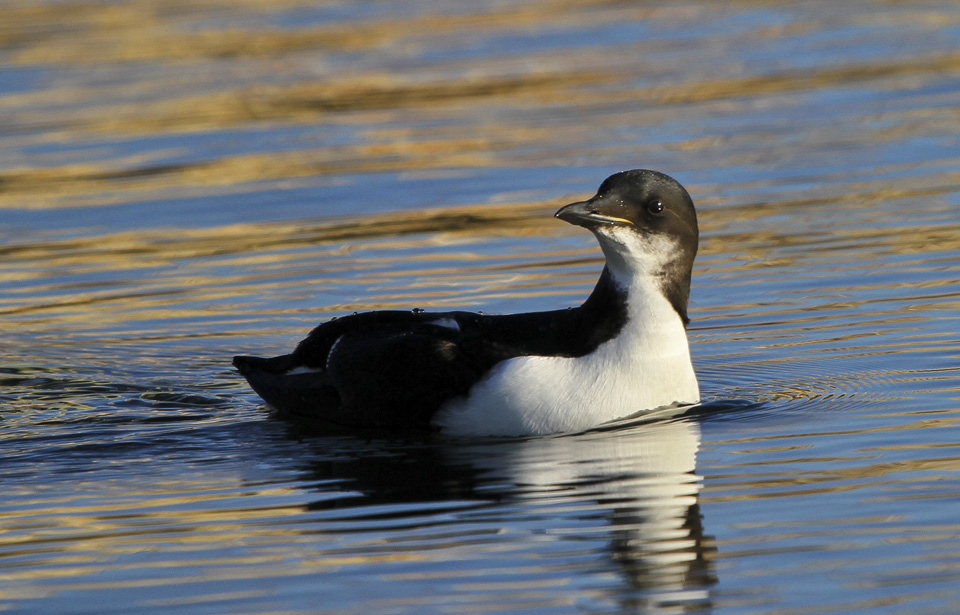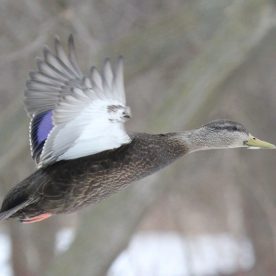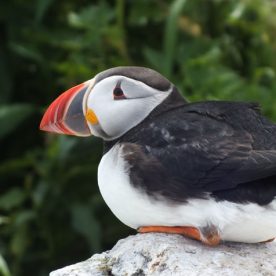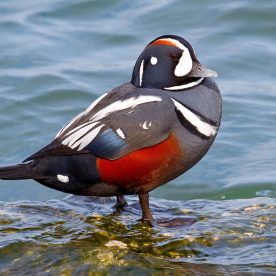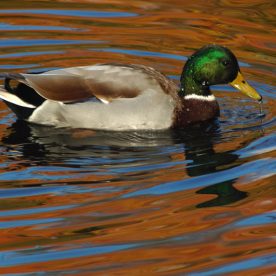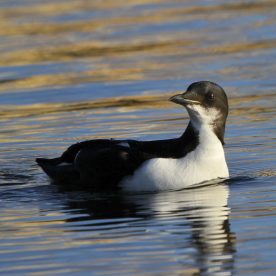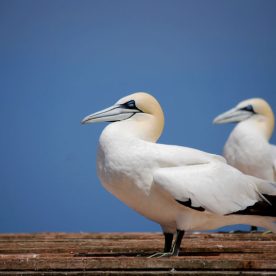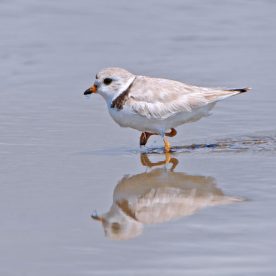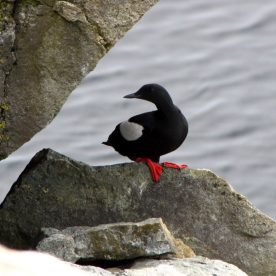Oil Pollution and Birds
- Oil may escape from ships through accidents or through deliberate dumping.
- Every year, more than 300 000 birds are killed by oil off the south coast of the island of Newfoundland alone.
- Many oiled birds that wash ashore must be humanely killed, because cleaning oiled birds is largely ineffective.
How Oil Harms Birds
Oil and birds don’t mix. The wrecked super-tanker, spewing a black tide of oil, has become a powerful symbol of ocean pollution and of humans’ destruction of the natural environment. So have the dying seabirds that strand on the beach, black with oil.
Oil kills birds in many ways. Its first effect is to break down the birds’ waterproofing. Water runs off a seabird’s back because the bird is protected by a layer of feathers, overlapping like the tiles on a roof (see Figure 1).
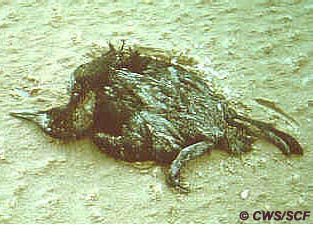 The fine structure of the feathers makes them waterproof. The separate strands, or barbs, in each feather are bound together by rows of tiny hooks, or barbules, into a tight weave that water cannot penetrate. Underneath is a layer of insulating downy feathers that allows the bird’s skin to stay warm, and beneath the skin is a layer of body fat that can add some insulation. This waterproof system works like a winter coat whose outer waterproof layer covers a thicker layer of material that traps air, keeping the wearer warm and dry.
The fine structure of the feathers makes them waterproof. The separate strands, or barbs, in each feather are bound together by rows of tiny hooks, or barbules, into a tight weave that water cannot penetrate. Underneath is a layer of insulating downy feathers that allows the bird’s skin to stay warm, and beneath the skin is a layer of body fat that can add some insulation. This waterproof system works like a winter coat whose outer waterproof layer covers a thicker layer of material that traps air, keeping the wearer warm and dry.
The system works well because the bird spends much of its leisure nibbling at its feathers, cleaning off any specks of dirt and rehooking the barbules. This preening keeps the feathers supple and waterproof. But it takes very little to disturb the intricate arrangements that make up a seabird’s feather “coat.” Oil destroys the coat by clogging the barbs and barbules, allowing cold water to soak into the insulating down and reach the skin. Even a small amount of oil—a spot no bigger than a quarter—may be enough to kill a seabird.
A healthy seabird maintains a body temperature of 41°C—about two degrees higher than the body temperature of humans—and has no problem swimming and diving in icy waters. But once the bird is touched by oil, its body heat drains away through the “tear” in its protective plumage. The bird tries to maintain its body temperature by burning its energy reserves stored as body fat, but these are soon exhausted.
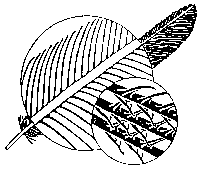 When fat reserves are used up, a bird will burn up its flight muscles to maintain body heat. It may also try to save itself by spending even more energy in search of food. In this pursuit it is handicapped by its extra burden of soaked feathers and weakness, and the exhausted bird will soon die. In the cold waters around the coasts of Canada, hypothermia is usually the cause of death.
When fat reserves are used up, a bird will burn up its flight muscles to maintain body heat. It may also try to save itself by spending even more energy in search of food. In this pursuit it is handicapped by its extra burden of soaked feathers and weakness, and the exhausted bird will soon die. In the cold waters around the coasts of Canada, hypothermia is usually the cause of death.
The bird’s other immediate response to oiling is to preen itself to try to restore the feathers’ waterproofing. Inevitably, as it preens, the bird inhales and swallows toxic compounds in the oil that can damage its liver, lungs, kidneys, intestines, and other internal organs. This poisoning can kill a seabird, but it is slower to take effect than is loss of body heat. Oil on the feathers of an incubating seabird may also be carried to its eggs, and if the oil soaks through the shell, it can kill the embryo or cause abnormalities in the developing chick.
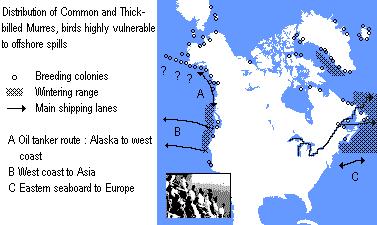
Birds Most at Risk
Diving birds are most at risk
The birds most vulnerable to spilled oil are those that dive to catch food underwater, because they spend much of their time sitting on the water between dives. In the Great Lakes, and in the near-shore waters of the Pacific and Atlantic coasts, loons, grebes, and diving ducks such as Long-tailed Ducks, mergansers, and eiders are the usual victims of oil spills. But dabbling ducks like American Black Ducks and Mallards are also frequent victims of oil spilled into the shallow coastal and inland waters of their habitat. Even Bald Eagles, which may feed on the oiled corpses along the tideline, can become oiled.
Further offshore is a population of seabirds unknown to most people. These are the pelagic seabirds, or birds that live mainly on the open sea. They include murres, Dovekies, Razorbills, puffins, and shearwaters, birds that are often caught in offshore spills. These pelagic seabirds may become oiled in coastal waters as well, because all seabirds must come to coastal islands to breed. Off Atlantic Canada Canadian Wildlife Service biologists have collected more than 20 species of oiled seabirds, about four fifths of them murres and Dovekies, pelagic seabirds which dive in pursuit of fish for food.
Oil spills can have more devastating effects on some bird populations than on others. Birds that lay several eggs are more likely to recover from deaths caused by oil spills than are those that lay fewer eggs. For example, populations of American Black Ducks, which lay clutches of five or more eggs, may rebound more quickly from oil-induced deaths than murres and other offshore species that lay only one egg a year.
Why do Spills Happen?
At any time there are hundreds of ships in the oceans off Canada’s coasts. Oil may escape from these ships in two ways: from accidental ship collisions and groundings or from deliberate dumping. The newsworthy accidents can release large volumes of oil into the environment, and they may result in the deaths of many water birds. For instance, when the Exxon Valdez ran aground in Alaska in 1989, about 30 000 dead birds were recovered, but it is estimated that the spill actually killed more than 300 000 birds.
Much more damaging than well-publicized collisions and groundings is oil that enters the oceans from ships that dump oily wastes. Such dumping is illegal, but many ships release waste oils from their engine room bilges to save the cost of pumping their oily wastes into onshore tanks when they reach port. This dumping is referred to as “chronic oil pollution,” because in some parts of the world it is a daily occurrence. Chronic oil pollution resulting from illegally dumped bilge wastes and from the cleaning of oil tanks kills hundreds of thousands of seabirds every year in Canadian waters. A recent study carried out at Memorial University of Newfoundland has estimated that every year more than 300 000 seabirds are killed off the south coast of the island of Newfoundland by oil illegally dumped by ships to save the cost of pumping it ashore. This equals the estimated kill of seabirds in the Exxon Valdez disaster and makes the waters around Newfoundland and Labrador the deadliest in the world for birds that are victims of oil spills.
We are aware of this intentional pollution because some of the birds killed by bilge oil discharges wash ashore. Canadian Wildlife Service studies have shown that 74 percent of the dead birds recovered from the beaches of southern Newfoundland and Labrador between 1994 and 1999 were oiled. Chemical analyses show that in more than 95 percent of cases, the oil that kills seabirds is heavy fuel oil, or heavy fuel oil mixed with diesel oil and lubricating oils, exactly the mixture which accumulates in the engine room bilges of large ocean-going ships.
However, most of the birds killed by oil never wash ashore—they are either carried offshore by winds or currents or they disintegrate before they drift to the shoreline. Experiments have shown that a dead bird drifting at sea will break up within two weeks and that a bird oiled farther out than 20 nautical miles or about 37 km will never wash ashore. For this reason, the number of birds that come ashore is much smaller than the number actually killed by oil, as in the case of the Exxon Valdez disaster, where about 30 000 of the estimated 300 000 birds killed by oil were recovered.
Oiled seabirds wash ashore most frequently in wintertime when the waters are coldest and severe winter weather puts added stress on the birds. At that time of year our offshore seas are crowded with birds, most of which breed in the High Arctic and come south to winter in more moderate latitudes.
What Can be Done?
What can be done to prevent illegal oil dumping at sea?
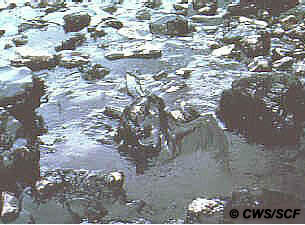 One way to prevent illegal oil dumping at sea is to bring polluters to court and make the guilty parties pay for the damage. But this is not simple. The Canadian government searches for illegal oil dumpers with pollution patrol aircraft on both the Pacific and Atlantic coasts, but the area of Canada’s Exclusive Economic Zone, which extends to 200 nautical miles, or about 370 km, off our coasts, is huge, and it is very costly to patrol. In the past, even when ships were caught dumping, fines were small and didn’t provide a sufficient deterrent. Today, fines imposed by the courts have increased greatly, but it is still difficult to catch ships that dump oil because some of them now dump at night when they cannot be seen by patrol aircraft. To catch these ships Canada is using RADARSAT. This is a satellite which uses radar to detect the calming effect of spilled oil on the water. A large area of ocean can be scanned by the satellite each time it passes overhead, and if an illegal dumper is detected, a pollution patrol aircraft is sent out in daylight to identify the ship and collect evidence.
One way to prevent illegal oil dumping at sea is to bring polluters to court and make the guilty parties pay for the damage. But this is not simple. The Canadian government searches for illegal oil dumpers with pollution patrol aircraft on both the Pacific and Atlantic coasts, but the area of Canada’s Exclusive Economic Zone, which extends to 200 nautical miles, or about 370 km, off our coasts, is huge, and it is very costly to patrol. In the past, even when ships were caught dumping, fines were small and didn’t provide a sufficient deterrent. Today, fines imposed by the courts have increased greatly, but it is still difficult to catch ships that dump oil because some of them now dump at night when they cannot be seen by patrol aircraft. To catch these ships Canada is using RADARSAT. This is a satellite which uses radar to detect the calming effect of spilled oil on the water. A large area of ocean can be scanned by the satellite each time it passes overhead, and if an illegal dumper is detected, a pollution patrol aircraft is sent out in daylight to identify the ship and collect evidence.
The research efforts of Canadian Wildlife Service and other scientists are also helping to catch oil dumpers. Oil found in a slick and on birds can now be matched to the ship from which it escaped. In addition, once offenders are brought to court, information about the number of birds killed by oiling and the impact on the growth of bird populations strengthens the arguments for finding the dumpers guilty and for imposing large fines.
In an attempt to reduce chronic oil pollution, Environment Canada and the Canadian Coast Guard have launched several programs to try to educate ships’ crews about the damage done by oil dumping. For example, the crews are given a multilingual brochure, “Oil Kills Seabirds,” which shows where seabirds are most vulnerable, and which emphasizes that every oil spill, however small, is a hazard. However, many of the ships that are responsible for chronic oil pollution of Canada’s seas do not even enter our ports. Instead, they simply pass through our waters on the way from one foreign port to another.
Large Oil Spills
Large oil spills in Canadian waters
In addition to chronic, purposeful oil pollution, Canada has had its share of large accidental oil discharges. In February 1970, the tanker Arrow ran onto a rock off the coast of Nova Scotia, spilling about 9 000 tonnes of bunker oil into the sea. Bunker oil is a heavy tar-like fuel oil that is used to power large ships. This was our first experience of a large tanker spill, and it alerted us to the huge environmental damage that can be caused. At least 2 400 oiled loons, grebes, diving ducks, and other water birds came ashore on the mainland and another 4 800 birds, mostly Dovekies and murres, were caught in the slicks that drifted out to Sable Island, 180 km offshore. Nobody knows how many more seabirds were oiled offshore, but did not reach Sable Island. Then in March 1979, the ship Kurdistan broke up off Nova Scotia, leaving a similar trail of oiled birds and beaches. On the west coast, after an accident in December 1988, the barge Nestucca spilled 800 tonnes of bunker oil into the Pacific Ocean off Washington State, and at least 30 000 oiled murres and Cassin’s Auklets came ashore there and in southwestern British Columbia. This was only a small fraction of the birds actually killed in this accident.
Most spills in Canadian waters have been much smaller, but the size of a spill often has little to do with the damage it can cause. Where and when it happens is more important. In March 1970, the barge Irving Whale spilled 30 tonnes of bunker oil between Prince Edward Island and the Îles-de-la-Madeleine in the Gulf of St. Lawrence, after a hatch came loose in a storm. The slick drifted across an eider feeding area, oiling about 5 000 birds. The toll was nearly as large as the Arrow’s, from a spill only one percent of the size. More recently, at least 17 500 oiled murres washed up in Placentia Bay, Newfoundland and Labrador, during the winter of 1989–1990. This pollution probably came from purposely dumped bilge wastes.
These marine incidents can be matched by others in inland waters. In December 1975, oil from an unknown source killed 2 800 diving ducks in eastern Lake Erie. Downstream, in the lower St. Lawrence, the marsh at Cap Tourmente is famous for its flocks of Greater Snow Geese in spring and fall. Most of the Greater Snow Geese that breed in the eastern Arctic stop there to feed during migration, grazing on the roots of grasses and sedges. In fall 1963, 140 ha of marsh were contaminated by about five tonnes of bunker oil, probably discharged from a ship’s ballast tanks. The oil threatened 70 000 geese and their food supply. Fortunately, a massive salvage operation cleared away the oil and tainted plants before most of the birds arrived, and no geese were lost to oil pollution.
In March 1999, the Gordon C. Leitch ran into the dock at Havre-Saint-Pierre on the north shore of the St. Lawrence River near Anticosti Island. A small hole was made in the hull of the ship, and about 49 tonnes of bunker oil was lost. During the weeks following the accident, some 1 100 water birds, mostly eiders, were found dead or in difficulty along the shores near Havre-Saint-Pierre.
So far, only a few small oil spills have occurred in Canada’s icy cold arctic waters, but the risk of more frequent, larger, oil spills exists—from offshore oil operations, from ships supplying arctic settlements, and from ships carrying materials to and from developing mining projects in the north. It is also expected that climate change will reduce the ice cover in the Northwest Passage, allowing freighters and tankers to pass between the Atlantic and Pacific oceans. A spill near the big Canadian seabird colonies in Baffin Bay or in the Northwest Passage could be disastrous. The remoteness of the region, its ice, and its harsh climate increase the chances of accidents to shipping and multiply the difficulties of dealing with them. Oil usually remains unchanged and toxic longer in cold waters than in warm, so the processes of natural recovery will likely be slower in the north than they would be farther south.
How do we Help?
How do we help affected birds?
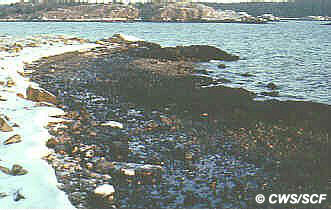 The Canadian Wildlife Service relies on several pieces of legislation—the Canada Shipping Act, the Fisheries Act,the Migratory Birds Convention Act, and the Canada Wildlife Act—to help it work with other government agencies to combat the effects of oil spills. When a disaster occurs, the Canadian Wildlife Service focuses on actions that will prevent more damage to wildlife and that ensure that oiled birds and species at risk are treated humanely.
The Canadian Wildlife Service relies on several pieces of legislation—the Canada Shipping Act, the Fisheries Act,the Migratory Birds Convention Act, and the Canada Wildlife Act—to help it work with other government agencies to combat the effects of oil spills. When a disaster occurs, the Canadian Wildlife Service focuses on actions that will prevent more damage to wildlife and that ensure that oiled birds and species at risk are treated humanely.
Humane treatment may mean cleaning an oiled bird and releasing it back to the wild. But it may also mean humanely killing the bird. This is because, while the natural reaction to an oiled bird is to try to undo the damage, in most cases, by the time a bird is captured, it is beyond our help. The small number of oiled birds that come ashore and can be captured are typically suffering from the poisoning effects of oil as well as the exhaustion of having used all their energy reserves in trying to preserve body heat. We have learned over the years that cleaning these birds is largely ineffective, so most oiled birds that are found alive must be humanely destroyed. The simple lesson is that once oil is spilled into the sea or fresh waters, it wreaks damage that is extremely difficult to repair. This is a situation that demonstrates the truth of the old saying, “Prevention is better than cure.”
Resources
Online resources
Print resources
Brown, R.G.B. 1991. The natural history of oil spills. In J. White, editor. The effects of oil on wildlife: Research, rehabilitation, and general concerns. The Sheridan Press. Hanover, Pennsylvania.
Burger, Joanna. 1997. Oil Spills. Rutgers University Press, Rutgers, New Jersey.
Burger, A. E. 1993. Estimating the mortality of seabirds following oil spills: effects of spill volume. Marine Pollution Bulletin 26(3): 140–143.
Chardine, J.W. 1991. Newfoundland: Crossroads for sea birds and shipping in the Northwest Atlantic. In J. White, editor. The effects of oil on wildlife: Research, rehabilitation, and general concerns. The Sheridan Press. Hanover, Pennsylvania.
Lock, A. R., R.G.B. Brown, and S. H. Gerriets. 1994. A gazetteer of marine birds in Atlantic Canada. Environment Canada, Canadian Wildlife Service, Atlantic Region.
National Research Council. 2003. Oil in the Sea III. National Academies Press, Washington, D.C.
Piatt, J.F., C.J. Lensink, W.B. Butler, M. Kendziorek, and D.K. Nysewander. 1990. Immediate impact of the Exxon Valdez oil spill on marine birds. Auk 107:387–397.
Wells, P. G. 2001. Oil and seabirds—the imperative for preventing and reducing the continued illegal oiling of the seas by ships. Marine Pollution Bulletin 42(4): 251–252.
© Her Majesty the Queen in Right of Canada, represented by the Minister of the Environment, 1992, 2003. All rights reserved.
Catalogue number CW69-4/85-2003E-IN
ISBN 0-662-34255-0
Text: R.G.B. Brown
Revision: A.R. Lock, 2003
Editing: Maureen Kavanagh, 2003
Photo: Jon Stone, Canadian Wildlife Service



